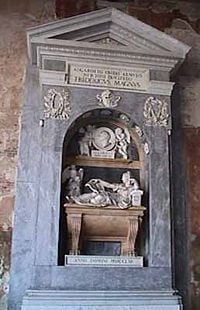Francesco Algarotti
Count Francesco Algarotti (11 December, 1712–3 May, 1764) was an Italian philosopher and art critic.
He was born in Venice to a rich merchant. He studied at Rome for a year, and then Bologna, he studied natural sciences and mathematics. At age of twenty, he went to Paris, where he became friendly with Voltaire and produced his Neutonianismo per le dame, a work on optics. Voltaire called him his "cher cygne de Padoue" ("dear swan of Padua"). Returning from a journey to Russia, he met Frederick the Great, who made him a Prussian count in 1740 and court chamberlain in 1747; they are said to have been lovers. Augustus III of Poland also honoured him with the title of councillor. In 1754, after seven years' residence partly in Berlin and partly in Dresden, he returned to Italy, living at Venice and then at Pisa, where he died. Frederick the Great erected to his memory a monument on the Campo Santo at Pisa. He was "one of the first beaux esprits of the age," a man of wide knowledge, a connoisseur in art and music, and the friend of most of the leading authors of his time.
His chief work on art is the Saggi sopra le belle arti ("Essays on the Fine Arts"). Among his other works were Poems, Travels in Russia, Essay on Painting, and Correspondence.
He was one of the main collectors of art for Augustus of Saxony's collection in Dresden. His choice of works reflects the encyclopedic interests of the Neoclassic age; he was uninterested in developing a single unitary stylistic collection, he envisioned a modern museum, a catalogue of styles from across the ages. For contemporary commissions, he wrote up a list for paintings he recommended commissioning, including to ask of history paintings from Tiepolo, Pittoni, and Piazzetta; scenes with animals from Castiglione, and veduta with ruins from Pannini. He wanted "suggetti graziosi e leggeri" from Balestra, Boucher, and Donato Creti.
ReferencesISBN links support NWE through referral fees
- This article incorporates text from the Encyclopædia Britannica Eleventh Edition, a publication now in the public domain.
- Haskell, Francis (1993). "Chapter 14", Patrons and Painters: Art and Society in Baroque Italy, 1980, Yale University Press, p 347-360.
fr:Francesco Algarotti gl:Francesco Algarotti it:Francesco Algarotti pt:Francesco Algarotti fi:Francesco Algarotti
Credits
New World Encyclopedia writers and editors rewrote and completed the Wikipedia article in accordance with New World Encyclopedia standards. This article abides by terms of the Creative Commons CC-by-sa 3.0 License (CC-by-sa), which may be used and disseminated with proper attribution. Credit is due under the terms of this license that can reference both the New World Encyclopedia contributors and the selfless volunteer contributors of the Wikimedia Foundation. To cite this article click here for a list of acceptable citing formats.The history of earlier contributions by wikipedians is accessible to researchers here:
The history of this article since it was imported to New World Encyclopedia:
Note: Some restrictions may apply to use of individual images which are separately licensed.
